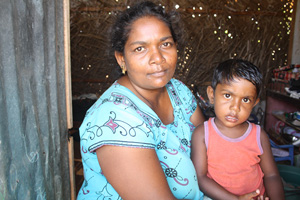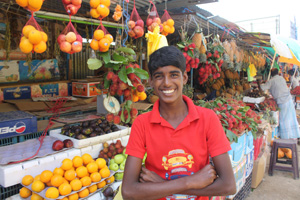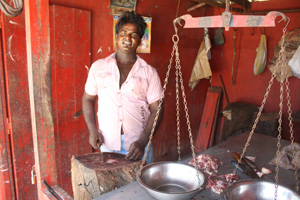
Ilankai Tamil Sangam
Association of Tamils of Sri Lanka in the USA
Published by Sangam.org
by IRIN Asia, Bangkok, July 9, 2012
|
In a recent nutritional survey in the north, the World Food Programme (WFP) estimated that more than 19,000 children under the age of five were suffering acute malnutrition... The preliminary findings of a 2012 comprehensive food security assessment (CFSA) by WFP, yet to be released, indicate that 44 percent of households in the five districts of Northern Province are food insecure (37 percent moderately food insecure and 7 percent severely food insecure). |
JAFFNA, 9 July 2012 (IRIN) - In Sri Lanka’s northern Jaffna District, Parameswary Rasakumar, 32, a mother of two, points to an assortment of red plastic containers on the floor of her makeshift shelter, holding what little food the family has. “That’s it. That’s all the food we have in the house at the moment.”
 |
| Parameswary Rasakumar struggles to feed her family. Photo: Contributor/IRIN |
Her husband works as a casual day labourer. “We no longer get any food assistance from the government and now have to buy food on credit. When my husband doesn’t work we go without.” A lack of basic services, including water supply and sanitation, is exacerbating living conditions.
Jaffna District comprises a peninsula and seven inhabited islands at the extreme northern tip of the island, and such stories are not uncommon among the more than 580,000 inhabitants, who are still recovering from a civil war that began in 1983 - one of the world’s longest conflicts.
Hundreds of thousands of people who fled the fighting have returned to Northern Province since the conflict between government forces and the Liberation Tigers of Tamil Eelam (LTTE), who had been fighting for an independent Tamil homeland, ended in 2009.
The province comprises five districts: Jaffna, Kilinochchi, Vavuniya, Mannar and Mullaitivu.
More than three years on, over 300,000 of the people displaced after 2008, when renewed fighting broke out, have returned to their places of origin in the north. This number includes almost 53,000 who have come back to Jaffna District, the UN Refugee Agency (UNHCR) said, where nearly 40 percent of these people are still living with host families.
But unlike most returnees in Jaffna, Parameswary was displaced more than 20 years earlier; underscoring the protracted humanitarian impact of this war.
Pockets of food insecurity remain across the north, including severe malnutrition, with many returnees now skipping meals and going into debt to buy food, aid agencies say.
In a recent nutritional survey in the north, the World Food Programme (WFP) estimated that more than 19,000 children under the age of five were suffering acute malnutrition.
 Photo: Contributor/IRIN |
Fruit and vegetables are easily found in Jaffna |
 Photo: Contributor/IRIN |
| Residents don't have any money, Rashkarn Marthraja says |
© 1996-2025 Ilankai Tamil Sangam, USA, Inc.